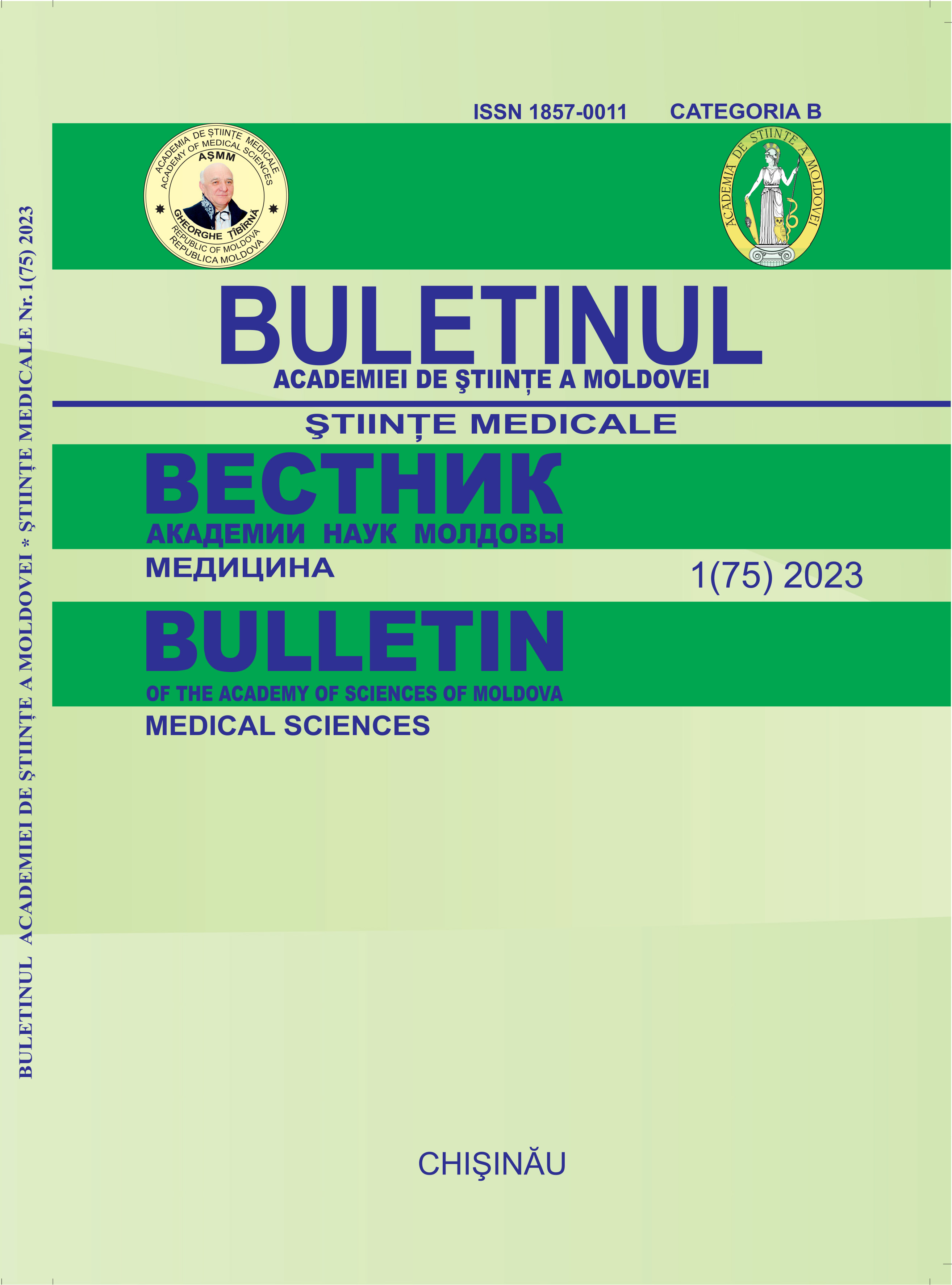NETosis and non-ST elevation acute myocardial infarction: pathophysiological significance and circulating markers
DOI:
https://doi.org/10.52692/1857-0011.2023.1-75.02Keywords:
NETosis, NSTEMI, circulating markersAbstract
Purpose. Evaluation of the role of neutrophil death (NET-osis) in the evolution of non-ST-segment elevation myocardial infarction (NSTEMI) by assessing circulating levels of in-patient admission of markers that are pathophysiologically related to this phenomenon. Material and methods. The research was carried out on a group of 54 patients with NSTEMI, undergoing coronary angioplasty in the laboratory of interventional cardiology within the scientific project of the State Program, in which the serum content of 7 biochemical markers was determined by the ELISA method: Selectin E, the molecule of intercellular adhesion 1 (ICAM-1), phospholipase 2 (PhA2), interleukin 8 (IL-8), neutrophil elastase (EN), myeloperoxidase (MPO) and metalloproteinase 8 (MMP-8). The control group consisted of 30 apparently healthy people. Results. The obtained results indicate the presence of significant incremental deviations of all explored markers in patients with NSTEMI compared to the control. The more specific markers of NETosis (MPO, NE and MMP-8) had a highest raising ratio, detected in a range of 88-151%. The other markers had a rate of circulating levels increase in a range of 50-74%. Conclusion. The admission circulating levels of specific markers of NETosis, myeloperoxidase, neutrophil elastase and MMP-8 are elevated in patients with NSTEMI by 88-151% compared to control, evidence, that indicates the pathogenetic role of NETosis as well as the plausible diagnostical and prognostical value of these markers.
References
Brinkmann V, Reichard U, Goosmann C et al. Neutrophil extracellualr traps kill bactreria. Science, 2004; 303:1532-1535.
Zhen C, Hailin Z, Lingzhi W et al. The Role of Neutrophil NETosis in Organ Injury: Novel Inflammatory Cell Death Mechanisms. Infklammation, 2020, 43(6):2021-2032.
Galluzzi L, Vitale I, Aaronson SA et al. Molecular mechanisms of cell death: recommendations of the nomenclature committee on cell death 2018. Cell Death and Differentiation. 2018, 25(3):486–541.
Papayannopoulos V. Neutrophil extracellular traps in immunity and disease. Nature Reviews. Immunology. 2018, 18(2):134–147.
Chen T, Li Y, Sun R et al. Receptor-mediated NETosis on neutrophils. Front Immunol, 2021, 12:775267.
Ysuaki A. Myeloperoxidase: Its role for host defense, inflammation, and neutrophil function. Arch Biochem Biophys, 2018, 640:47-52.
Pietronigro EC, Della Bianca V, Zenaro E, Constantin G. NETosis in Alzheimer’s disease. Frontiers in Immunology, 2017, 8:211.
Shahzad MH, Feng L, Su X et al. Neutrophil Extracellular Traps in Cancer Therapy Resistance. Cancers (Basel), 2022, 14(5):1359.
Bonaventura A., Montecucco F., Dallegri F et al. Novel findings in neutrophil biology and their impact on cardiovascular disease. Cardiovasc. Res, 2019, 115:1266–1285.
Bonaventura A, Vecchie A, Abbate A, Montecucco F. Neutrophil Extracellular Traps and Cardiovascular Diseases: An Update. Cells, 2020, 9(1):231.
Ge L, Zhou X, Ji WJ et al. Neutrophil extracellular traps in ischemia-reperfusion injury-induced myocardial no-reflow: Therapeutic potential of DNase-based reperfusion strategy. Am. J. Physiol. Heart Circ. Physiol, 2015;308:H500–H509.
Borissoff JIc Joosen IA, Versteylen MO et al. Elevated levels of circulating DNA and chromatin are independently associated with severe coronary atherosclerosis and a prothrombotic state. Arterioscler Thromb Vasc Biol, 2013, 33: 2032–2040.
You J, Hally K, Larsen PD, Holley AS. Increased levels of low-density neutrophils (LDNs) in myocardial infarction. Acta Cardiologica, 2022, 10:1-8.
Ogura Y. Neutrophil elastase deficiency ameliorates myocardial injury post myocardial infarction in mice. Int J Mol Sci, 2021, 22(2):722.
Yu X, Kennedy RH, Liu SJ. JAK2/STAT3, not ERK1/2, mediates interleukin-6-induced activation of inducible nitric-oxide synthase and decrease in contractility of adult ventricular myocytes. J Biol Chem, 2003, 278(18): 16304–16309.
Fujii M, Bessho R. Neutrophil elastase inhibitor sivelestat attenuates myocardial injury after cardioplegic arrest in rat hearts. Ann Thorac Cardiovasc Surg, 2020, 26(5):263–269.
Zhang N, Aiyasiding X, Li WJ et al. Neutrophil degranulation and myocardial infarction. Cell Commun Signal, 2020, 20:50.
Wang L, Pan J, Sun Y et al. Increased neutrophil elastase and proteinase 3 are closely associated with occurrnence and severity of stroke and acute myocardial infarction in patients with type 2 diabetes mellitus. Diabetes Research and Clinical Practice, 2022, 186:109853.
Zhang N, Wang JX, Wu XY et al. Correlation Analysis of Plasma Myeloperoxidase Level With Global Registry of Acute Coronary Events Score and Prognosis in Patients With Acute Non-ST-Segment Elevation Myocardial Infarction. Front Med (Lausanne), 2022, 9:828174.
Ali M, Pulli B, Courties G. Myeloperoxidase Inhibition Improves Ventricular Function and Remodeling After Experimental Myocardial Infarction. JACC Basic Transl Sci, 2016, 1(7):633-643.
Maiocchi SL, Ku J, Thai T et al. Myeloperoxidase: a versatile mediator of endothelial dysfunction and therapeutic target during cardiovascular disease. Pharamcol Ther, 2021, 221:107-111.
Vora AN, Wang TY, Hellkamp AS. Differences in shortand long-term outcomes among elder patients with ST-elevation versus non-ST-elevation myocardial infarction with angiographically proven coronary artery disease. Circ Cardiovasc Qual Outcomes, 2016, 9:513-522.
Chaikijurajai T, Tang WHW. Myeloperoxidase: a potential therapeutic target for coronary artery disease. Expert Opin Ther Tar, 2020, 24:695-705.
Helseth R, Kleveland O, Ueland T et al. Tocilizumab increases citrullinated histone 3 in non-ST segment elevation myocardial infarction. Open Heart, 2021, 8(1):e001492.
Downloads
Published
License
Copyright (c) 2023 Bulletin of the Academy of Sciences of Moldova. Medical Sciences

This work is licensed under a Creative Commons Attribution 4.0 International License.



